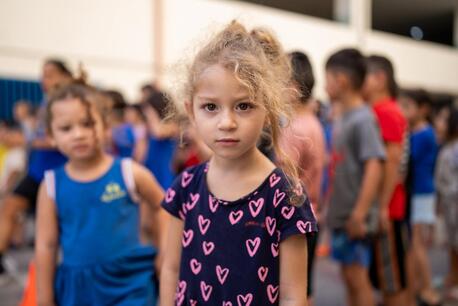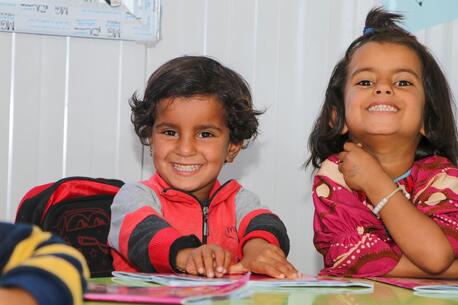Facing Danger Each Step They Take, Children Flee Violence and Hardship
UNICEF reports on child refugees’ harrowing journeys to Europe.
Real Risks Every Step of the Way
“If you try to run, they shoot you and you die. If you stop working, they beat you. It was just like the slave trade,” explains Aimamo, 16, a Gambian teen refugee.

Two boats — now impounded by the Italian government and stored in a “graveyard” in Pozzallo, Sicily — used by Libyan smugglers to ferry refugees across the sea to Italy. ©UNICEF/UN020015/Gilbertson VII Photo
Aimamo and his twin brother were compelled to work on a Libyan farm for two months to pay for their perilous Mediterranean crossing to Italy.
“We should never forget that children on the move are, first and foremost, children.”
Their experience might sound like an episode from Lemony Snicket's A Series of Unfortunate Events or Harry Potter. But unaccompanied children on the run face many real dangers. War, despair and poverty in their home countries force them on these desperate journeys.
“We should never forget that children on the move are, first and foremost, children, who bear no responsibility for their plight, and have every right to a better life,” says Marie-Pierre Poirier, UNICEF Special Coordinator for the Refugee and Migrant Crisis in Europe.
Unfortunately, child refugees — particularly unaccompanied ones — often rely on smugglers of human “cargo,” usually under a “pay-as-you-go” deal. This leaves them open to exploitation, trafficking and abuse.
More Child Refugees Every Day
UNICEF reports that 7,009 unaccompanied children made the crossing from North Africa to Italy in the first five months of 2016, twice as many as last year.
[[{"fid":"47709","view_mode":"default","fields":{"format":"default","field_file_image_alt_text[und][0][value]":"An instruction sheet for asylum applications for boys, mostly from Mali, Gambia, and other West African nations, at a government reception center that doubles as a lodging station for unaccompanied minors in Pozzallo, Sicily, Italy.","field_file_image_title_text[und][0][value]":""},"type":"media","attributes":{"alt":"An instruction sheet for asylum applications for boys, mostly from Mali, Gambia, and other West African nations, at a government reception center that doubles as a lodging station for unaccompanied minors in Pozzallo, Sicily, Italy.","class":"media-element file-default"}}]]
Outside an Italian temporary shelter housing approximately 110 children in Pozzallo, Sicily, a boy looks at an instruction sheet for asylum applications. ©UNICEF/UN020013/Gilbertson VII Photo
A total of 2,809 deaths were recorded in the Mediterranean between January 1 and June 5, 2016, compared to 3,770 during 2015. Many were children.
And the crisis may soon get worse. Another 235,000 migrants — tens of thousands of them unaccompanied children — are currently in Libya, frantic to cross the sea to Europe.
What Happens When They Arrive
The unprecedented scale of the refugee crisis has strained welfare systems in host countries.

Jannat R., 7, a refugee from the destroyed Syrian city of Homs, draws with other child refugees at an emergency shelter in Berlin. She and her family arrived in Germany after making a weeklong journey from Turkey by land and sea. ©UNICEF/UN05628/Gilbertson VII Photo
“Even when children reach their destinations, they still need protection.”
For example, a study by UNICEF and the German government found that even children who arrived in Germany with their families can suffer violence, abuse and exploitation.
Imagine how much more vulnerable unaccompanied child refugees are.
Moreover, as children wait for their asylum applications to be processed — which can take months — they don’t always have access to real schooling, adequate psychosocial support or the chance to play.
“Even when children on the move have reached the relative safety of their destinations, they still need protection, education, health care and counseling. We must be by their side,” says Poirier.
HOW TO HELP
There are many ways to make a difference
War, famine, poverty, natural disasters — threats to the world's children keep coming. But UNICEF won't stop working to keep children healthy and safe.
UNICEF works in over 190 countries and territories — more places than any other children's organization. UNICEF has the world's largest humanitarian warehouse and, when disaster strikes, can get supplies almost anywhere within 72 hours. Constantly innovating, always advocating for a better world for children, UNICEF works to ensure that every child can grow up healthy, educated, protected and respected.
Would you like to help give all children the opportunity to reach their full potential? There are many ways to get involved.





